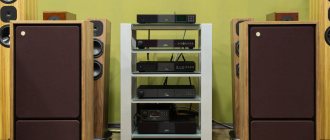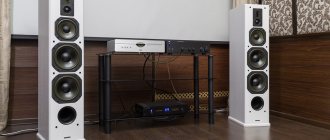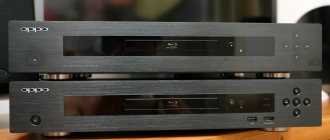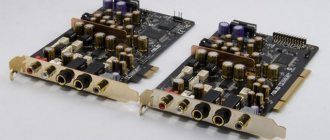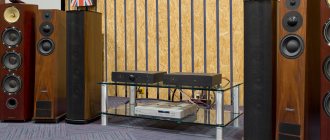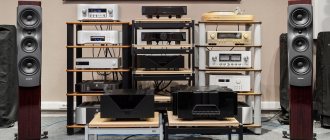What's inside Uniti Atom?
We've gone to great lengths to maximize the sound quality of this compact player. A massive transformer providing reliable and stable power and all analog and digital components - every element of the Uniti Atom was evaluated in the context of its impact on the overall sound quality.
Class A/B amplification
The Uniti Atom player is equipped with a 40-watt class A/B amplifier, built on the basis of the legendary NAIT integrated amplifier.
A massive transformer, high-quality components and premium Burr Brown DACs also contribute to Naim's signature audiophile sound.
Advanced WI-FI module
The new Uniti Atom is equipped with an incredibly powerful 40-bit SHARC 4th generation digital signal processor. Naim's proprietary algorithms eliminate jitter and resample digital data. All this is done in the smallest fractions of a second and significantly improves sound clarity.
Local storage
Store up to 20,000 tracks on a USB drive and play your music on any Naim streaming device.
In a multi-room system, you can stream music from UNITI NOVA to network players (up to 4 devices).
INTRODUCTION
Having involuntarily started writing reviews (no one forced me, but I certainly didn’t plan this), I dedicated my first stories to the experience of getting to know the portable: CA Solaris, Cayin N6-II, QLS 361. But if you dig deeper, I started everything -from the hospital! Moreover, quite consciously, driven by a love of music and a craving for freebies - these were reviews, which grew into audiophile essays, about the Dali Oberon 5 and Marantz PM6006, which I own. And all this for the sake of participating in a competition with a prize in the form of a Denon BT speaker. Spoiler alert, I didn't win the column. But he gained something more valuable - experience, although the texts were far from without sin, they were noticed and subsequently published by the organizers on social networks. And this, in turn, gave impetus to my graphomania in the field of audiophilia.
You understand what I'm getting at. Today in my tenacious paws (it’s more logical to talk about ears, but are they tenacious?) the device is purely stationary, and not for use with headphones, no, it provides for work as part of a home stereo system as the main and main operating scenario. That's why it's interesting. To me. Of course, the interest of the local public in such devices is predictably lower, but it exists. Each of us who is interested in portables, sooner or later begins to think about an acoustic system, but for some, living conditions do not allow it, while others settle on decent multimedia acoustics. For example, after 3 years with a wonderful representative of this class of stereo systems in the form of the Edifier R2700, I decided to take a step towards, albeit budget, but already Hi-Fi (whatever this term means). This text is for them, the eternally suffering.
I once wrote about the Aune X8 DAC, which I use in my home setup, and also several times used the reviewed DACs/headphone amplifiers as a DAC/pre for a stereo amplifier and shared this experience in reviews. Particularly noteworthy was the experience with the Focal Arche, which as a DAC demonstrated the ceiling of the possibilities of pairing my acoustics and amplifier. But now we can talk about the upper limit of the capabilities of acoustics itself. After all, now I have another representative of High-End class devices visiting me, only this time it has an amplification path. So let's listen to what the Oberons are capable of in this misalliance.
Enhanced Naim App
The intuitive new Naim App makes it easy to control one or more Uniti players. You have access to all your music, including your favorite Internet radio stations, streaming services, playlists and discographies and artist biographies. Updating your system wirelessly is just one click away! The Naim App can be used to control any Naim streaming device.
SOUND
In the introduction to this part, I would like to clarify that I realize that by connecting such a high-end device to acoustics, albeit high-quality ones, but at a budget level, I will not see the full potential of the device. However, the speakers demonstrated a more than noticeable difference between working with the current path and with Atom. I heard the ceiling of acoustic capabilities. Now we have to live with it.
The first thing I would like to write about is the scene. Naim doesn't just create a wide stereo panorama, it shapes and builds an imaginary scene in great detail and meticulously, creating incredibly realistic plans. Due to this technical separation of plans, a genuine feeling of the holographic nature of the scene, its correct geometry and localization of sounds in space is created. A delightfully realistic effect, which Focal Arche previously came very close to, but in its case the bottleneck was an amplifier whose potential was much lower than that of the DAC.
In the case of Atom, nothing prevented him from painting the picture that he can and that Oberon 5 is capable of. Depth - and we are not talking about the depth of sound that the bass substrate creates from a powerful and sophisticated sub-bass - captures and does not give be distracted by nothing. If you want to listen to music in the background, forget it! Your attention will constantly cling to those little things and moments that you were previously deprived of. Sit comfortably (in my case this means on the floor, the speakers are not high) - and you will be carried away like Dorothy and Toto to the land of Oz.
In addition to the depth of the stage and the volume in general, the next thing that catches your ear is the excellent localization of instruments in space and the definition of sounds. These are clear strokes, with defined boundaries and very harmonious transitions: the sound has the highest resolution and technicality, however, this is not the dry, unemotional sound of studio equipment. The integrity of the presentation of musical material has been preserved.
In this case, I mean not so much the amount of detail revealed to us by Atom (although here too it will pleasantly surprise you), and in general the emphasis on microdynamics, but rather some kind of hyper-realistic rendering of the very texture of sounds and after-sounds. This is a feeling of the physics of sound itself, and we are not talking about massiveness and weight, density and impact, but rather about the tactile component. Things that are understandable only to people with an acute incurable form of audiophilia.
Everything in the phonogram is perfectly audible and distinguishable; the player pleases with its information content and omnivorousness. Internet radio (by the way, Naim has its own studio under its wing - Naim Records, and its own Internet radio station, delighting with a high-quality and varied repertoire), Spotify Premium do not sound bad, by no means, but Tidal, as well as lossless files from a local server, demonstrate a clear superiority of such content on this path. I’m generally silent about DSD files. Atom takes a very high-quality and attentive approach to the elaboration of all those smallest nuances of the recording, which feed our passion, audiophilia, without allowing it to fade. The reverberations and resonances of the instruments are perfectly distinguishable, the definition and airiness of the upper register perfectly conveys the emotionality of the sound of the recording.
Airiness, detail, cool rendering of textures and natural timbres are on one side of the scale, on the other is Atom’s work with the lower register. I don't want to call the low frequencies bad or underdeveloped, God forbid, but there is some dryness and lightness in the range that becomes noticeable when listening to heavy music. LFs have excellent speed and resolution, Atom perfectly conveys the very texture of the bass, but places less emphasis on the psychophysical component - mass, density, weight. Yes, the low frequencies are great in their technicality, but as soon as you turn on something heavier or electronic music, over time you realize that you want more depth and mass. But otherwise the low frequencies are pleasing: they are fast, sharp, articulate, have no problems with attacks and demonstrate exemplary dynamics.
Here I would bring to Atom's somewhat conditional genre versatility. It is without exaggeration great with acoustic styles (typically, this is the main component of Naim test selections), it has enough scale for complex classical music (Rachmaninov's Piano Concerto No. 1 sounds with the required scale), rock, blues and their derivatives are dynamic, lively, with wonderfully conveyed timbres of instruments, but with metal there is a little lack of fat in the low frequencies, massiveness.
Master of puppets sound with excellent aggression in the mids, the guitars are luxurious, but the bass lacks weight.
Scandroid perfectly demonstrates the work of Atom with low frequencies: it conveys their dynamics, attack, elasticity, if necessary, without any pretense. High definition bass, tight and punchy. But light, dry and biting. Perhaps Atom with acoustics that deliberately emphasized the massiveness of the low frequencies would have performed better. We also don’t forget about the possibility of connecting an active subwoofer (however, you should take into account that the Atom does not provide a separate crossover for the subwoofer).
Now where Naim reveals itself is here! It’s hard to say how many times I listened to this particular composition from the selection for this essay! Absolutely beautiful dynamics, naturalness and detail emphasize the magnificence of the composition and its performance and once again force you to reconsider Damien Chazelle’s Possession.
Once upon a time, in a review of Lotoo paw 6000, I mentioned that we, audiophiles, often define sound by geographical criteria, and gave a description of the sound characterized as “English” - a conventional concept that can be used to describe an acoustic model in which the main emphasis is on elaboration mid-frequency range. A little rough and too general, but very close. And we don’t forget where Naim comes from - the city of Salisbury (this is where those spiers are).
If we accept these conventions, then the sound is, yes, English, no less English than the tea in my mug (no joke, it was bought on Oxford Street). Dry, biting bass, with good articulation and attack, but somewhat lightweight, on which a structure of warm, superbly crafted midrange frequencies and airy, clearly defined high frequencies is built, filling the space with overtones.
Mid frequencies captivate and subjugate the will of the listener. Naim sounds natural and big, and the whole space is filled with the sound (the middle is the most informative part of the spectrum) of instruments and voices. And their high-quality elaboration, and the transmission of textures and roughness, delineation in space is the key to both the transmission of emotions and the capture of the listener’s attention and involvement. I’ll say it again, listening to Atom as background music while working is a bad idea. I personally could not distract myself from thoughtful listening. Perhaps this is out of habit, but I cannot emphasize this feature.
Ennio Morricone and Quentin Tarantino. It's like the Avengers, only in reality. Even if it’s CINEMA reality. Excellent transmission of space and sounds in it. Atom has a remarkable extension of after-sounds in the upper register, it is a pity that the acoustics - I am sure of this - did not allow the maximum of its capabilities to be shown.
Avant-garde jazz from the Poles from Niechęć. The upper and lower mids are like fire and ice: the driving and tight lower mids are seamlessly combined with the piercing and crystal clear sounding saxophone.
I'd like to mention the vocals separately. Nick Cave is not Mercury, but no one can argue with the fact that he is cool in his own way! Charisma and attractive dark emotionality, coupled with a non-trivial image (in some rating, Cave was included in the top 5 ugliest performers). Niam conveys all these notes that form Cave as a wonderful frontman perfectly.
Speaking about high frequencies separately, I will once again regret that at one time I did not part with my second kidney and took a Dali Epicon! Although Oberon is equipped with a tweeter made using the same technology as used in older models, I still consider the true potential of Atom in this area not to be revealed on my system. But if we neglect this, then the Atom showed the highest detail in this spectrum, extracting everything that was possible from the Oberon. They are truly great, I tried all sorts of material and couldn't find anything to complain about.
After Marantz (it’s not a competitor, of course, it’s like a background. A background in the form of a carpet on the wall, if you like), an unconcealed clarification occurs in the upper register, all sounds become crystal clear and unusually clear, and their after-sounds become more pronounced, a more defined layering acquires , which, together with the elaboration of stage plans, provides scale, depth of scene construction and air. Air, without exaggeration, there is a lot of it here. My 18 square meter living room has become a miniature Albert Hall.
In my audiophile bins there is a wonderful recording - a tribute to Miles Davis from the artists of Chesky Records. The album itself is a complete demo test record. The exceptionally exemplary quality of the recording was most evident when listening to Naim: during the process, the feeling of switching to an uncompressed format after mp3 did not leave. Yes, in terms of HF, Atom clearly indicated its place in my path, God forgive me. How informative, how rich, how much you can hear!
Recording from another Chesky release, unfortunately, the mentioned tribute was not found on YouTube. Plates VE-LI-KO-LEP-NY! And the air, and the cymbals and the geometry of sound... Bring tranquilizers, phenazepam no longer helps.
Another composition that you will enjoy listening to even from the radio. And if the path corresponds to the artistic value of the work... Need I say that the entire upper spectrum is brilliantly worked out? The resonances of the strings are conveyed with a feeling of characteristic vibration, and when a tambourine is struck, every sound and overtone is localized and separated. Supremely magnificent.
As already mentioned, the Atom's power is very modest, however, this in no way affects the dynamics and control in the low-frequency region. Naim Uniti Atom retains the dynamics and texture of low frequencies even when listening at low volumes, and as for the volume, I have not been able to raise the volume above 70 units out of 100, but this is on DSD with DR12.
Well, let's touch on a slightly closer topic for most of the local public - sound in headphones. I sneakily mentioned that the Atom has a headphone output, but until now I had avoided its performance in this guise - a headphone amplifier.
Unfortunately, during the test there was nothing at hand other than CA Andromeda, and therefore the review will be through the prism of the capricious multi-driver hardware. The headphone output is quite powerful, but noisy. Therefore, heavy artillery was used in the form of ifi iematch.
As a result, the noise is reduced to zero. The sound from the headphone output, in general, is not at all similar to its sound with acoustics. The bias towards warmth is much more noticeable; the sound is not so expressive and enchanting, but much more unified, with a clear emphasis on the midrange and more massive low frequencies. Listening through the headphone output, we deprive ourselves of that air and separation of images, detail and elaboration of plans that are characteristic of Atom in a more familiar operating mode. I think that tight dynamic headphones would have opened up the Atom's headphone tract to the best advantage, otherwise I would define it as warm and very tasty. I know a lot of fans of this presentation, and the right headphones will help fully reveal this side of the Naim Uniti Atom.
Development by Uniti
Developed by our engineers and designers in Salisbury, the Uniti range remains true to our core principles. From the chiseled heatsink ridges to the finished black aluminum chassis, from the new proprietary volume control to the illuminated pedestal, every small detail was considered in the context of reference-quality sound quality. Uniti is a true masterpiece of industrial design.
Hi-Fi, feng shui
It’s worth starting a conversation about sound with a lyrical digression about the features of acoustics. The thing is that these seemingly harmless kids turned out to be quite capricious in terms of location in the room and in relation to the listener. We managed to figure out the location of the tweeters quite quickly. The optimal installation is with the tweeters facing inward and the speakers facing the listener. This is how you can get a wide scene, with good depth and natural stereo images. I would also like to note that placing tweeters at ear level or ear level with tweeters gives a noticeable increase in sound quality. So if you plan to listen to Neat Iota in an adult way, as the Hi-Fi canons dictate, keep this in mind.
Signature recordings from Naim Records are worth listening to
If the system will be used for background sound, and the task is to fill the room with sound, it is worth turning the speakers so that the radiation axes are parallel, and perhaps even swap the left and right speakers or place them on their sides.
But that is not all. Neat Iota also reacts very quickly to the location in the room, or more precisely, the distance from the wall. Even when the speakers are on stands half a meter from the wall, moving them literally 5-7 centimeters gives an audible effect in terms of the nature of the reproduction of low frequencies. It's hard to believe, but if you place them too close to the wall, there can be a lot of bass.
Precision volume control
Uniti uses an audiophile discrete analog volume control with digital control. Its design is derived from the NAC-N 272 streaming preamp and our reference Statement amplifier system. The illuminated segments of the volume control are also displayed on the intuitive remote control. There is a hidden Bluetooth antenna built inside the volume control.
Great in small
All the experiments with acoustics described above remain behind the scenes when you come to listen to an already installed set, and it is precisely this first acquaintance that is guaranteed to leave an indelible effect. Listening to a system with a very clear, dynamic and quite mature sound, you involuntarily look for a full-size stereo pair or at least a small subwoofer hidden somewhere (by the way, the Uniti Atom has a subwoofer output, and organizing a triphonic on its basis will not be difficult). A simple check shows the integrity of the experiment: one component and a pair of microspeakers play.
The character of the system's sound was quite soft, neat, with enveloping warmth in the lower mids and bass, as well as extremely clear, transparent and well-balanced upper ones.
And the developers didn’t forget about beautiful music visualization
And then, as usually happens with a good-sounding system, the test tracks begin to be sorted from one to another in order to reveal the limit of the possibilities. After all, it can’t be that absolutely everything plays perfectly! Acoustic music, vocals, light audiophile jazz, popular and simple academic music from different eras - this is what the combination copes with almost perfectly.
The system was somewhat puzzled by heavy music, which sounded generally good, but it no longer lacked intelligibility in the low-frequency range. Another way to load the system is to play progressive rock or free jazz. Layering complex rhythms of bass, drums and percussion did not always develop in the usual way. At the same time, straight rhythms, fast or slow, sounded absolutely clear, regardless of whether it was an old AC/DC record or a modern dance hit.
There could be an HDMI port with ARC support under the flap, but you'll have to pay extra for that
Speaking of dance music: this set coped very well with EDM, and the sound character was ideal for loud listening in a city apartment. There is a feeling of a huge booming bass filling the dance floor, but there is no thumping in the chest or the clinking of dishes in the cupboards. Therefore, the neighbors will not come without an invitation.
Under the hood
You can look under the hood of any Uniti component on the official Naim website, and although not all key elements are indicated there with eloquent captions, everything you need is visible without the manufacturer’s comments. The first thing you notice is that the Nova has the largest power transformer. Even the Star, which is comparable in size, has a smaller transformer. This means that we are not just looking at an Atom blown up to Supernova size, but officially the most powerful component in the series.
Minimum conductor lengths, well-thought-out mutual arrangement of boards - this case contains enough High-End technology for a stereo system
And while we are studying the anatomy of the device, I want to note how closely Naim follows its own ideology, in particular, the idea of reducing the length of the conductors as much as possible. The leads of the toroidal transformer are extremely short and are located in such a way as to reach the solder points on the boards over the shortest distance. And the boards themselves are not only spaced at different levels and vibrationally isolated from each other to minimize mutual influence, they are also located so that the cables and conductors connecting them have a minimum length.
The set of connectors is typical for Naim: “get your DIN cables ready, gentlemen!”
From the point of view of the idea of minimum signal distances, the devices included in the Uniti line are superior to systems based on separate components in the same way that a High End system is superior to a Bluetooth speaker. No connectors, extra soldering, long cables with unknown properties, etc. And at the same time, another ideology is observed - the separation of components, because each board is the equivalent of one Hi-Fi component, maximally isolated from the other electrically and mechanically.
SuperNova
There is one very notable component in the Uniti line called Atom. Its positioning on the market is absolutely clear and explainable; I would say that it is a variation on the theme of the successful Mu-so devices, but without built-in acoustics. A unique Hi-Fi class music center. Or High End, if you don’t spare money on acoustics.
The visual division of the case into two parts should be understood as “player + amplifier”
With their larger brothers Uniti Star and Uniti Nova, the situation is more complicated. Both devices are the size of full-fledged hi-fi components, but offer similar functionality and an even heavier price tag. The most controversial of them is Uniti Nova, because it is, in fact, the same Atom, only twice as large and twice as powerful. What is the difference then and why pay more, I decided to figure it out.

